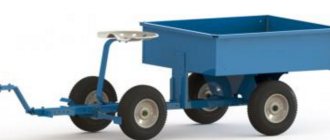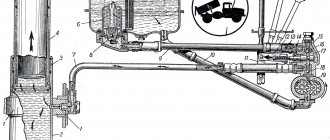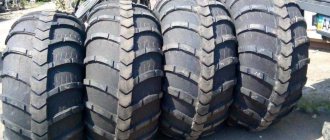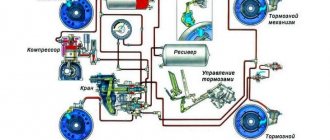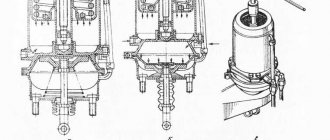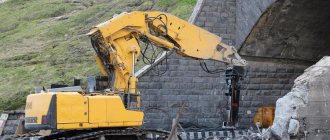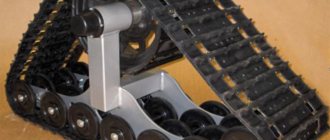If you want to say thank you to the author, just click the button:
Each hydraulic system, in addition to the pump, actuating hydraulic motors and hydraulic distribution equipment, contains valves. The number of valves, depending on the complexity of the system, varies from a few to several dozen, and in some cases their number is measured in hundreds. This article will describe the main types of valves most commonly found in hydraulic systems:
- Safety valves
- Reducing valves
- Check valves
- Controlled check valves
- Brake (counterbalance) valves.
Basic principle of valve operation
The principle of operation of the simplest valve is to balance the force created by the pressure of the working fluid on the seat area and the elastic force of the spring. The valve seat is a structural element that forms a working edge that ensures a tight fit of the shut-off element. The simplest valve has the design shown in Figure 1a. In the body 1 there is a working edge, to which the locking element 2, pressed by the spring 3, fits tightly. The force created by the spring 3 determines the pressure difference between the cavities P and T at which the valve opens. Figure 1b shows the valve in the open state, where the arrows indicate the direction of movement of the working fluid. Two-stage valves, depending on their purpose, can have different designs and will be discussed below.
Classification
There are several types of valves based on the type of shut-off element. The most common are: spherical (ball), conical, flat (see Figure 2). Due to their high sealing properties and manufacturability, spherical (ball) and conical valves are most widely used.
By installation method
There are valves of cartridge, pipe, butt (flange) and modular installation. Cartridge valves are further divided into screw-in (threaded) and embedded. There is another category - frameless valves. Frameless valves are typically a collection of valve components designed to be installed in a valve plate or body.
Cartridge and frameless valves can be used in a hydraulic system only as part of a valve block or installed in an individual housing. In Fig. 3, using the example of a valve block, cartridge and frame valves are shown before installation and in the installed state.
Pipe mounted valves have threaded ports for connecting hydraulic lines. Butt-mount valves are usually designed to be installed directly on a hydraulic unit (for example, a hydraulic cylinder or motor) and are secured by a group of threaded fasteners. Pipe and butt mounted valves are shown in Fig. 4. and fig. 5.
The subgroup of butt-mounted valves includes modular hydraulic equipment SETOR (see Fig. 6). Depending on the maximum flow of working fluid, the equipment is divided into several groups: CETOP 02, 03, 05, 07 and 08. The list of CETOP components includes a whole range of hydraulic components: these are all kinds of valves, hydraulic valves, flow control equipment, and even filtration of working fluid. All elements are mounted in groups or individually on mounting plates. An example of assembling a hydraulic system based on the CETOP 03 element base is shown in Fig. 7.
Safety valves
The safety valve is a short-term pressure control valve. It is installed in the hydraulic system to limit the maximum possible pressure in the line. Each hydraulic system has a safety valve in the high pressure line leaving the pump. Safety valves can be installed in lines where the pressure must not exceed a specified value. For example, safety valves are installed in the supply line of hydraulic motors to limit the pressure in them and, as a result, limit the maximum force generated by the motor. In addition to those mentioned above, safety valves have many typical applications.
According to GOST 2.781-96, safety valves on the diagrams are designated as shown in Figure 8.
In circuit designs, a safety valve can be used to ensure a minimum specified level of pressure or backwater in a hydraulic system line. In this application, safety valves are usually called retaining valves, which reflects the nature of their operation.
The design of a direct-acting safety valve is shown schematically in the figure. 9. A conical locking element 2 is installed in the body 1, pressed against the seat by a spring 3. The spring is adjusted with an adjusting screw 4. The locknut 5 is used to fix the adjusting position of the screw. The movable spring support 8 is sealed along the gap with the body 1. The closed volume 6 and the gap 7 act as a vibration damper for the valve shut-off element. Direct acting valves have a high response speed, which is their main advantage. Disadvantages include unstable operation and a tendency to self-oscillation. Also, as operating costs increase, the valve size also increases significantly.
Indirect-acting valves, which are often called two-stage or servo valves, do not have such disadvantages. The design of such a valve is shown in Figure 10. The main locking element 2 is pressed to the body seat 1 by a spring 9. The locking element has a throttle hole 3. The working cavity is separated from the drain line T by a pilot valve with a locking element 4, pressed to the seat by a spring 5. Adjustment mechanism The spring preload consists of an adjusting screw 7 with a lock nut 10, a support 6 and a seal 8.
The valve operates as follows: when the pressure in line P is below the valve response setting, the pressure levels in the working cavity and line P are the same, the main shut-off element is pressed against the seat by spring 9. The initial positions of the valve elements are shown in Figure 10. When the pressure reaches the pilot setting value valve, the latter opens, and the working fluid, passing through throttle hole 3, rushes into line T. When the working fluid passes through the throttle hole, a pressure difference is created between line P and the working cavity. This pressure difference acts on the locking element 2 and, overcoming the force of the spring 9, moves, which leads to the opening of the main valve.
What is it and why is it needed?
A bypass valve, also known as an overflow valve, is a device that regulates the pressure in the system by bypassing or draining an excess volume of the working medium (gaseous or liquid) into another circuit. The peculiarity of the unit is that it is capable of doing this continuously, which differs from its safety analogue, which reduces the pressure in the pipeline by one-time or periodically removing the medium from it.
A similar pressure reducer, in contrast to the overflow unit, maintains a stable pressure of liquid in the flow following from it, while the overflow unit maintains a stable pressure before itself.
Installation features
*
The specific installation location of the bypass device depends on the layout and type of pipeline. The valve can be integrated into an additional diverter circuit. For closed-cycle heating systems, excess pressure is released into the return pipeline. It can also be used as a safety valve, adjusted to emergency pressure and with liquid discharge into the sewer system.
In a single-circuit heating main circuit, the bypass valve is installed in the bypass outlet after the injection pump.
Bypass valve for local heating system. Installation diagram.
For greater safety and security of the entire heating circuit, it is advisable to install additional ones in addition to the bypass device:
- check valve to prevent reverse flow direction,
- air vent valve for bleeding air pockets,
- drain valve to completely drain the media from the system,
- for small-diameter cottage-type systems - mesh filters.
In multi-circuit systems, bypass valves are installed in each circuit.
Areas of use
The valve is used in pipelines where increased pressure of the working medium may occur.
In cars, it dumps excess exhaust gases that spin the turbine blades, thereby reducing the pressure in the intake manifold. This ultimately protects the engine from overheating and failure. In the fuel supply and cooling lines, it drains the excess generated under pressure into the fuel tank and expansion tank, respectively.
This fitting is widely used in heating and hot water supply devices, where it ensures the rational functioning of all heating devices and pipeline sections. In combination with balancing and other valves, the fittings act as a pressure regulator.
Mechanism
The design includes a metal body (cast iron, bronze, brass), inside of which there is a damper and a spring that activates it. The valve can be a spool valve, a plate, etc. Another option is a shut-off membrane with a rod. A handle is built into the body, which is used to adjust the device.
Devices used in large networks and large-diameter pipelines may contain a lever-load mechanism in their housing.
Bypass valve design:
Principle of operation
The coolant, water, and gaseous medium, moving through the pipeline, exert pressure on the valve, which is held in place by a spring. As soon as the pressure force reaches a predetermined level, the valve opens and the excess volume of the working medium is discharged through a special branch into another circuit of the system.
After the level drops to normal, the spiral returns the valve to its original position and the contents of the pipeline continue to circulate.
With a membrane mechanism, the passage for the coolant under the influence of pressure is opened by the membrane. When the pressure returns to normal, the membrane returns to its original place.
In a car, the turbine bypass assembly has a damper, the full opening or closing of which depends on the activator lever. The length of its pull can change over time under the influence of various factors. Therefore, this is monitored and the traction is adjusted.
Specifications
The main quantities that determine the operation capabilities of bypass devices in the system:
- Passage diameter. Internal cross-section of the carrier passage through the valve. May differ from the diameter of the main circuit of the system.
- Bandwidth. Characterizes the volume of the working medium capable of passing through the valve per unit time at a nominal pressure of 1 atm. Measured in cubic meters/hour.
- Ultimate pressure. The maximum value of excess pressure for which the device is designed to operate. Exceeding this parameter in the system leads to displacement of the valve rod and the beginning of media bypass. Determined at a carrier temperature of 20 °C.
- Setting range. The limits of the possibility of adjusting the excess pressure at which the valve begins to open. The unit of measurement is bar.
Adjustment scale with tuning slider
Types and designs
According to the operating principles, bypass valves are distinguished with spring and membrane designs. Spring mechanisms prevail in systems where the pipeline cross-section is no more than 200 mm; in other water supply and heating networks, the lever-load principle is used.
Membrane units are increasingly used when working with liquid media that contain solid particles.
Depending on the pipeline environment, bypass devices are intended for:
- gas;
- pair;
- liquids.
According to the purpose of the system, they are used for pipelines:
- cold water supply,
- hot water supply,
- heating,
- cooling,
- conditioning.
In heating and water supply systems, bypass valves are distinguished according to their purpose:
- for radiators;
- for boiler and bypass;
- for automatic replenishment;
- for low or high pressures.
This photo shows an overflow valve with a setting scale. Made of bronze and brass, designed for installation in central heating systems.
Along with bypass regulators, the following is installed in the heating design:
- air vent to prevent air locks in pipes;
- three-way valve for mixing or separating hot and cold water flows;
- reverse, preventing backflow in the pipeline.
For industrial and utility networks, designs with a nominal diameter DN of up to 500 mm and a flange connection are used.
In the car there are access devices for:
- turbines;
- fuel supply mechanism;
- engine cooling systems.
The turbine bypass unit discharges the exhaust gases, reducing the pressure force in the manifold. Thus, it protects the engine from overheating.
In the fuel pipeline, the overflow unit regulates the rate of gasoline supply in it by draining the excess pumped to the engine by the gasoline pump back into the fuel tank.
Types of bypass valves
Although the operating principle and performance characteristics are similar, the devices have additional differences.
Connection method
On small diameter pipelines (up to 150 mm), the inlet and outlet pipes are usually made with a threaded connection. Options - external or internal thread of the pipe. For large cross-section pipelines, connections are made by welding or using flange connections.
Large Diameter Flanged Valves
Flow direction
*
The valve installed in the main flow usually has an angular shape for connecting the outlet circuit. Valves included in the bypass line can also be direct-flow.
Direct Flow Bypass Valve
Active element
Typically, the outlet is blocked by a shutter or damper. But in some designs, the locking element is a diaphragm connected to a rod. The use of diaphragm options is recommended in pipelines with a working medium containing solid particles in addition to liquid or gas.
Mechanism of action
The difference in the method of influencing the shut-off element led to the emergence of two types of valves.
- Direct action. A simple mechanical device in which the coolant directly acts on the active element of the valve. Inexpensive and relatively easy to maintain.
- With elements of indirect influence. It actually consists of two valves. The small diameter valve works as a pressure sensor and, when activated, controls the main valve rod, which opens the drain into the bypass channel. Characterized by more precise adjustment of the response threshold.
Selection tips and approximate prices
When choosing a bypass device, the consumer must be aware that it is designed to ensure normal operation of the system and constantly maintain stable pressure inside it.
Such a device must meet the following requirements:
- help reduce pressure, quickly redirect excess coolant volume to another circuit;
- have a sufficient range of adjustment;
- be suitable for the method of connection to pipes, for example, have a threaded connection for pipes with a diameter of ½′′.
The throughput device is selected, first of all, based on the type of working medium of the pipeline: gas, steam, water.
Next, they are guided by certain criteria.
Criteria
The main ones are:
- features of the actuator;
- pipeline type and configuration;
- valve material;
- device diameter (DN), which should not be less than the cross-section of the supply pipe;
- range of pressure drops supported by the device;
- damper capacity, characterized by maximum and minimum Kvs values;
- operating and maximum media temperature.
The specific operating pressure to which the valve must be adjusted is specified in the data sheet.
It is important to provide for correct installation, for which everything must be correctly calculated taking into account the parameters and configuration of the system. For example, in a complex heating structure, it is better to install an overflow regulator behind all pumps, and additionally use check valves to protect them.
You should pay attention to the reliability of suppliers so as not to run into counterfeit products.
The approximate price for bypass valves for domestic use varies from 1,700 to 5,200 rubles. Industrial designs equipped with measuring instruments, flanges, and a wide range of settings are much more expensive.
Thus, the overflow angle valve shown in the photo with DN ¾”, designed for 0.06-0.36 bar, with an adjusting head, will cost 1,680 rubles. It is installed to ensure normal operation of the pump. Drains excess coolant when the pressure in the radiators is exceeded into the return line.
If you have to purchase a bypass device for a car, you must take into account all the features of the previous one, and do not chase after cheap fakes.
Product functions
The functions of such a device are to promptly discharge excess coolant volumes and thus reduce its pressure level. The general requirements for such nodes are that they must:
- help reduce pressure by promptly discharging excess coolants.
- have precise settings, and for heating systems in residential premises it is desirable that the settings be manual.
- have high strength and reliability.
- ensure the safe operation of heating systems thanks to the reliability of its own design.
Types of bypass valve designs
The bypass valve for heating systems can be of two types, characterized by operating principles. The most common is the spring version, but the lever-load version is mainly used in large highways. The principle of operation of the spring device is that during movement the coolant presses on a special valve, which is restrained by a spring.
When the pressure level is equal to the compression force of the spring, the safety rod opens and excess liquid begins to be discharged using the outlet pipe. After the situation returns to normal, the spring returns the valve to its original position, and the coolant continues to move without restrictions.
Heating system bypass valve
Spring devices are used in systems in which the pipe diameter does not exceed 200 millimeters; in other cases, a lever-load design is used. Its difference from the lever one, first of all, lies in the fact that in the absence of a spring, the rod is fixed using an additional weight, the weight of which can vary. In this case, the critical indicator is adjusted with a certain error, and the adjustment itself is performed by changing the weight of the load.
